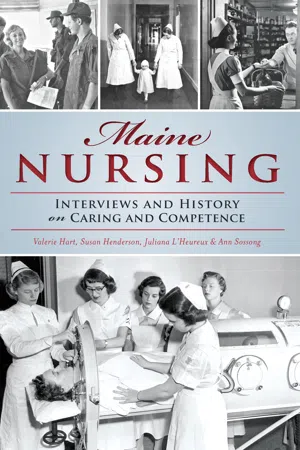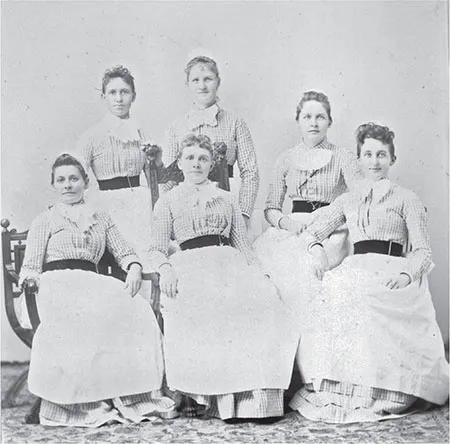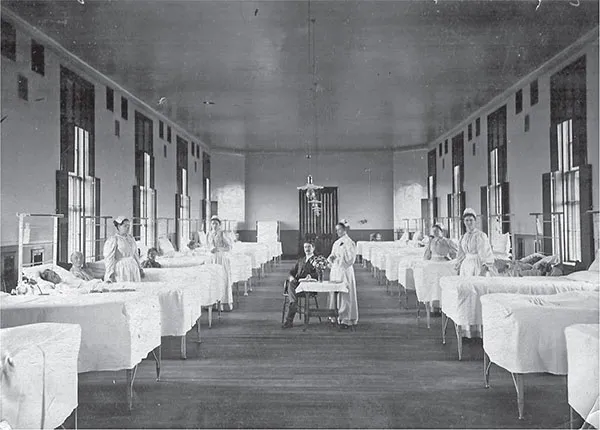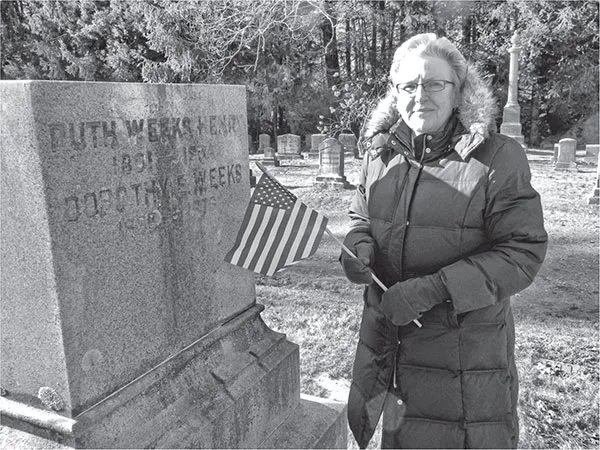
eBook - ePub
Maine Nursing
Interviews and History on Caring and Competence
- 192 pages
- English
- ePUB (mobile friendly)
- Available on iOS & Android
eBook - ePub
Maine Nursing
Interviews and History on Caring and Competence
About this book
Maine nurses have served tirelessly as caregivers and partners in healing at home and abroad, from hospitals to battlefields. The Division of Public Health Nursing and Child Hygiene was established in 1920 to combat high rates of infant mortality in Washington and Aroostook Counties. During the Vietnam War, Maine nurses helped build the Twelfth Evacuation Hospital at Cu Chi and bravely assisted surgeries in the midst of fighting. In the early 1980s, nurse disease prevention educators in Portland rose to the challenge of combating the growing AIDS epidemic. Through historical anecdotes and fascinating oral histories, discover the remarkable sacrifices and achievements of Maine's nurses.
Frequently asked questions
Yes, you can cancel anytime from the Subscription tab in your account settings on the Perlego website. Your subscription will stay active until the end of your current billing period. Learn how to cancel your subscription.
At the moment all of our mobile-responsive ePub books are available to download via the app. Most of our PDFs are also available to download and we're working on making the final remaining ones downloadable now. Learn more here.
Perlego offers two plans: Essential and Complete
- Essential is ideal for learners and professionals who enjoy exploring a wide range of subjects. Access the Essential Library with 800,000+ trusted titles and best-sellers across business, personal growth, and the humanities. Includes unlimited reading time and Standard Read Aloud voice.
- Complete: Perfect for advanced learners and researchers needing full, unrestricted access. Unlock 1.4M+ books across hundreds of subjects, including academic and specialized titles. The Complete Plan also includes advanced features like Premium Read Aloud and Research Assistant.
We are an online textbook subscription service, where you can get access to an entire online library for less than the price of a single book per month. With over 1 million books across 1000+ topics, we’ve got you covered! Learn more here.
Look out for the read-aloud symbol on your next book to see if you can listen to it. The read-aloud tool reads text aloud for you, highlighting the text as it is being read. You can pause it, speed it up and slow it down. Learn more here.
Yes! You can use the Perlego app on both iOS or Android devices to read anytime, anywhere — even offline. Perfect for commutes or when you’re on the go.
Please note we cannot support devices running on iOS 13 and Android 7 or earlier. Learn more about using the app.
Please note we cannot support devices running on iOS 13 and Android 7 or earlier. Learn more about using the app.
Yes, you can access Maine Nursing by Valerie Hart,Susan Henderson,Juliana L'Heureux,Ann Sossong in PDF and/or ePUB format, as well as other popular books in History & North American History. We have over one million books available in our catalogue for you to explore.
Information
Chapter 1
BUILDING FOUNDATIONS OF A PROFESSION
1914–1919
Nursing care was based on compassion, justice and social reform by early nursing leaders.4 The period from 1890 to 1920 was known as the Progressive Era, during which political and social reforms were needed to serve growing populations and diverse communities. As the Industrial Revolution intensified, Americans moved from farms into cities to work in factories, and immigration increased. Conditions in tenements around factories were overcrowded. Factory workers, including children, often toiled long hours in unsafe workplaces. In the urban areas, unhealthy conditions and lack of support systems resulted in the need for more care to be provided in institutions.
For most of the 1800s, hospitals were unsanitary places staffed with few informed caregivers. Concern about patient safety was “the primary goal underlying the adoption of formal nursing in the United States.”5 Florence Nightingale, the founder of modern nursing, established the Nightingale School for Nursing at Saint Thomas Hospital in London in 1860. She had saved thousands of lives in the Crimean War in the 1850s because she recognized the importance of sanitation and good ventilation. During the Civil War, Nightingale was an advisor to the United States Sanitary Commission, whose mission was to establish conditions conducive to health in military camps and hospitals. A committee from the commission visited New York’s Bellevue Hospital; its report of this visit reflected abysmal conditions and unsafe patient care. This report influenced Bellevue Hospital to open the first training school for nurses in America, based on Nightingale’s model, in 1873.6
As the number of hospital training schools around the nation grew rapidly, problems included lack of program admission standards, exploitation of students as workers and lack of opportunity for adequate clinical education.7 Nursing leaders identified the need for standards of nursing education and for laws to protect the public. This awareness led to the development, in the 1890s, of two organizations that later became the American Nurses Association (ANA) and the National League for Nursing (NLN). By 1903, North Carolina had become the first state to pass laws related to the registration of nurses, followed by New York, New Jersey and Virginia.8

A nurse of the first graduating class of Central Maine Medical Center, 1893. Courtesy of CMMC.
The development of nurse training in Maine followed national patterns of large and small hospitals creating training schools for nurses. Mabel Hammons, a graduate of the Eastern Maine General class of 1899, stated: “In 1897–99, graduate nurses were capable of going into a home; making a room surgically clean; preparing a patient for operation, even for abdominal surgery; administering ether anesthesia by drop method; giving nursing care, post-op, for two or three weeks. Cash compensation $18 per week. So far as I know, we never lost a case.”9
REGISTRATION OF MAINE NURSES
Maine nurses participated with the American Nurses Association (ANA) to develop standards of education and to promote legislation for the registration of nurses. At a meeting of the Maine General Alumnae Association in 1908, participants discussed forming a state nursing association. The Maine State Nurses Association (MSNA) was incorporated on December 10, 1914. Edith L. Soule, superintendent of the Children’s Hospital in Portland, was elected the first president. The newly organized MSNA advanced a proposal for a bill to register nurses. The bill for state examination and registration of nurses passed in the state legislature and was signed into law on March 18, 1915.10 Each nurse who was registered received a pin with a picture of a pine tree and the words “registered nurse” on the front side and the nurse’s registration number on the back side. Speaking of the work of its legislative committee, the MSNA report stated: “To this committee and Mr. C.L. Andrews of Augusta, we are indebted for the passage of a bill which we feel compares very favorably with bills in other states and will result in much good both to the nurses and to the public.”11 MSNA’s curriculum committee proposed a curriculum that set a minimum standard for a two-year hospital course; this proposal was adopted.12 Thus, by 1915, Maine nurses had formed the Maine State Nurses Association as a part of the ANA and had begun the work to protect the health of Maine people and to develop the profession of nursing.

The beginning of a profession: Maine General graduates, 1890s. Courtesy of MMC.

A Maine General ward. Edith Soule is the second nurse on the right. Courtesy of Hobbs Collection, South Portland Historical Society.
PUBLIC HEALTH NURSING
In her 2006 doctoral dissertation, Martha Eastman discussed the epidemics of smallpox, diphtheria, scarlet fever and other infectious diseases in the late 1800s and early 1900s. She described the difficult processes of isolation, fumigation and disinfection used on patients with infections as they either died or recovered. In Maine, seaports provided a challenging environment when a ship came in with smallpox cases on board. Eastman described the practice of scrubbing those infected with the disease before they were allowed in public. When the patients’ rashes were almost gone, they were bathed with soap and water, rinsed and then scrubbed with a solution of corrosive sublimate before being dressed in disinfected clothes. When there was smallpox in the logging camps, it was the practice for a person—often a man called a nurse (regardless of his training)—to travel to the camps, usually by canoe, to disinfect, fumigate and scrub the loggers.13
Tuberculosis (TB) was a leading cause of death in the early part of the twentieth century. Both state and voluntary organizations played a role in working for public health. Some nurses worked through the Red Cross and others through the Maine Anti-Tuberculosis Association.14 There were efforts by state and voluntary groups to increase education and treatment of TB.
The Maine Anti-Tuberculosis Association of Piscataquis County and Dexter opened a dispensary in Milo in 1915. Clarissa Johnson, a nurse who graduated from Presbyterian Hospital in New York City and worked at a settlement house in Boston before coming to Maine, was hired to staff the dispensary, visit homes and promote health. In an article published in the Piscataquis Observer on health topics, Johnson wrote:
The only reason that the nurse’s work has developed into such broad lines of social service is the fact that she has the privilege of entering the homes. She comes in working dress and is very willing to give a bath, make a bed, change a dressing, or render some other service, which can be interpreted in terms of friendliness. This service is actual to the patient and family. Other problems besides sickness meet her on every threshold—lack of employment, delinquency in children or adults, bad sanitation, poverty and ignorance in every form. The public health nurse cannot help being a social service worker, for in recognizing her responsibility toward the family health, she must also regard the family as a part of the community, and therefore sees the civic aspect of her work and becomes a social part of the health campaign.15
The role of the public health nurse required sensitivity, empathy and the ability to communicate across cultural and economic lines. Providing education acceptable to families was critical. Sometimes it became necessary to remove children from homes. The early public health nurses needed to work to win and maintain cooperation of all community members, including physicians.16
WORLD WAR I
The Red Cross Nursing Service was established by the Nurses’ Associated Alumnae and the Red Cross in 1909. Red Cross enrollment was accepted by the War Department as a reserve for the Army and Navy Nurse Corps for service in World War I (1914–18), in which twenty million people died.17
Ruth Weeks Henry, a 1914 graduate of the New England Deaconess Training School for Nurses in Boston, later initiated the Red Cross home health program in Bath, Maine. Henry was one of sixty-five nurses of the Harvard Unit that, under the leadership of Harvey Cushing, MD, became part of the staff of Base Hospital No. 5 in France. This group was considered to be “the first (Americans) in France,” arriving a full year before American troops. Its first job was to replace exhausted British hospital staff in Dannes-Camiers for six months and then in Bologne for fourteen months. Both groups cared for massive numbers of patients with head injuries, gas poisoning, trench fever, shell shock and self-inflicted wounds. Patient and staff casualties also resulted from enemy bombing.18

Marla Davis at Ruth Weeks Henry’s grave. Courtesy of Juliana L’Heureux.
The organizational structure of nurses in military service in that period had its own challenges. The nurses began their wartime service affiliated with the Red Cross but were militarized to aid their deployment and movement. Although their Army Nurse Corps assignments included the supervision of enlisted corpsmen, nurses were not commissioned officers; this lack of authority led to considerable tension. Nursing leaders and women’s rights activists campaigned for recognition of nurse leadership and in 1920 won “relative rank,” which was described as quasi-officer status.19
INFLUENZA OUTBREAK
A flu pandemic spread across the world in 1918, taking an additional twenty-seven million lives worldwide. In Maine, Bath was particularly affected due to maritime activity; approximately 2,320 cases and fifty-five deaths were reported. Three nurses—Harriet Bliss, Alice Dain and Adelaide Hogue—lost their lives caring for flu victims in temporary quarters around the city.20 Mercy Hospital in Portland started as Queens Hospital at the corner of State and Congress Streets in 1918 by the Sisters of Mercy to treat the flu victims.21 Mary Catherine Ragan described what she remembered about the flu outbreak:
I graduated in 1942 from the Queens; it was a small hospital. Flu was severe in Maine. We had friends that lived in a three-flatter. There was a death on the first, second and third floors. It was all the same family. I don’t remember the flu, but I do remember the way they talked about it. In fact, there were no public gatherings. Near Queens Hospital is Saint Dominic’s Church. They couldn’t have a Mass inside, so the priest said Mass on the top of the stairs, and the people were out on Gray Street, listening. My mother and father attended that because we lived nearby.
From 1900 to 1920, Maine nurses worked in homes, hospitals and communities and served on battlefields to provide knowledgeable and compassionate care:
It is significant to note that modern nursing began to develop during a period when social, economic and industrial problems were colossal, and interest in the humane treatment of individuals was high. In adapting to demands for health care, pioneer nurses began to express concern for the specific needs of the sick. This was and is nursing’s unique contribution to health care.22
Chapter 2
NURSING AFTER WORLD WAR I...
Table of contents
- Front Cover
- Half Title
- Title Page
- Copyright
- Contents
- Acknowledgements
- Introduction
- 1. Building Foundations of a Profession: 1914–1919
- 2. Nursing After World War I and the Great Depression: 1920–1939
- 3. World War II and Changes in Healthcare: 1940–1959
- 4. Growth of Healthcare, Technology and Professional Autonomy: 1960–1979
- 5. Era of Healthcare Reform and Cost Containment: 1980–1999
- 6. Considerations of Quality and Outcome Measurements: 2000–2015
- Notes
- About the Authors